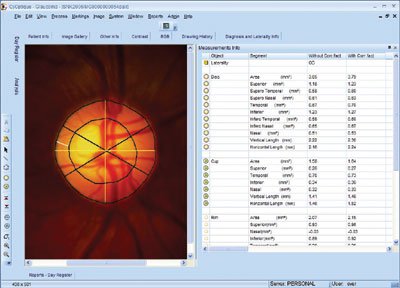Semi-automated device may prove valuable to glaucoma diagnostic arsenal
A new device might be a faster, less costly alternative to more advanced diagnostic technologies that require added clinical expertise.
 Ramesh S. Ve |
A semi-automated planimetry tool used to assess optic nerve head neuropathy shows promise for the diagnosis of glaucoma and monitoring of glaucomatous progression, a physician said.
The CyOptique-GL (Cynaptix Technologies) measures optic nerve head dimensions on a 20° or 30° centered fundus image, dimensions that most glaucoma associations worldwide require for the clinical diagnosis and management of the disease, Ramesh S. Ve, MPhil, PhD, said in an email interview with Ocular Surgery News.
“The automated process of disc and cup margin detection makes it a quick and effective modality to quantify the [optic nerve head] damage,” Dr. Ramesh said.
Results from a study that Dr. Ramesh and colleagues conducted examining sensitivity and specificity of the device were presented in a scientific poster at the 2010 ESO International Vision Science and Optometry Conference (EIVOC) in August. The device was assessed by medical professionals at a leading eye hospital and research organization, Sankara Nethralaya, in Chennai, India. It is for glaucoma use only; Cynaptix is currently working on an automated retinal image analyzer for early diabetic retinopathy changes, Dr. Ramesh said.
The CyOptique-GL is an add-on tool that works on color optic nerve head images, providing only two-dimensional data, Dr. Ramesh said. This contrasts with other more advanced and expensive technologies, such as the Heidelberg Retina Tomograph (HRT, Heidelberg Engineering), GDx (Carl Zeiss Meditec) and optical coherence tomography, which all provide three-dimensional profiles of the optic nerve head or measure peripapillary retinal nerve fiber layer thickness, Dr. Ramesh said.
“It might be impractical for every clinic to have advanced image analyzing tools in their clinical patient management,” he said. “[In combination] with just a fundus imaging tool, CyOptique-GL could be useful in clinical care for glaucoma.”
 Optic disc and cup markings along with planimetry measurements of optic nerve head image. Image: Ve RS |
Methods, results
The study presented at EIVOC drew its subjects from the Chennai Eye Disease Incidence Study, including 476 healthy control patients and 81 glaucoma patients. Those with pseudophakia, aphakia and other ocular pathologies were excluded from this analysis.
Subjects categorized as normal had reliable visual field as measured through frequency doubling perimetry screenings, with an error score of less than two and no ocular abnormalities.
The CyOptique-GL measured the optic disc area, cup area, neural rim area, cup-disc area ratio, vertical cup-disc ratio, horizontal cup-disc ratio and the disc and cup lengths, both horizontally and vertically.
In detecting subjects with glaucoma, the CyOptique-GL achieved an 83% to 92% sensitivity score and an 80% to 93% specificity score, the highest scores shown for any of the diagnostic tools included in the analysis. HRT demonstrated a 64% to 75% sensitivity score and a 68% to 80% specificity score; GDx showed a 72% to 82% sensitivity score and a 56% to 82% specificity score; and OCT achieved a 76% to 79% sensitivity score and a 68% to 81% specificity score.
Study limitations
The optic nerve head measurements of glaucoma patients were compared to age-matched control patients, which might have resulted in higher validity measures for the CyOptique-GL, according to Dr. Ramesh. Moreover, he said that the study acquired its validity measurements for the other diagnostic tools from previously published reports.
Cross-sectional, longitudinal research should be conducted, comparing all optic nerve head assessment tools in the same study sample, Dr. Ramesh said.
“The overlap between [healthy patients] and [the] glaucoma group in larger disc might affect the discriminating ability, which could be reduced by including more number of subjects,” the study authors wrote in the poster.
The CyOptique-GL could be used by a variety of medical professionals in place of more expensive imaging tools that require additional clinical expertise, Dr. Ramesh said. In the future, the device could also become a valuable diagnostic aid.
“As most clinics across the globe are getting equipped with fundus imaging tools, glaucoma diagnosis and management could be made more effective by using this software,” he said. – by Michelle Pagnani

- Ramesh S. Ve, MPhil, PhD, can be reached at Sankara Nethralaya, Medical and Vision Research Foundation, 18 College Road, Chennai, Tamil Nadu, India-600006; +00914442271840; email: optorameshgp@gmail.com.
- Disclosure: Dr. Ve does not have any direct financial interest in any of the products discussed in this article, nor is he a paid consultant for any companies mentioned.

![]()
The authors conclude that CyOptique-GL demonstrates high sensitivity and specificity to objectively determine the presence or absence of glaucomatous optic neuropathy in normal and glaucomatous patients. These patients were already clinically classified as such based on perimetry and optic disc evaluation.
However, the study does not evaluate CyOptique-GL’s usefulness in the more clinically challenging group of glaucoma suspects. Any new tool to help diagnose glaucomatous optic neuropathy would need to be effective in this patient population as well, requiring further studies with longitudinal prospective data collection and evaluation. It would also be beneficial to determine estimates of reproducibility for CyOptique-GL and to evaluate the software’s potential for monitoring longitudinal changes of the optic nerve. This study was a first step, but ultimately, CyOptique-GL’s usefulness in clinical practice needs to be established with further research.
— Tomas M. Grippo, MD
Clinical Glaucoma
Fellow, University of California, San Diego, U.S.A.
Disclosure: Dr. Grippo
does not have any direct financial interest in any of the products discussed in
this article, nor is he a paid consultant for any companies mentioned.
